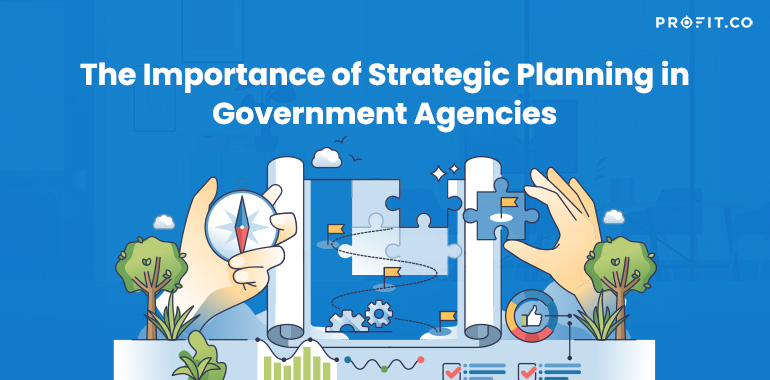Strategic planning isn’t just a nice-to-have; it’s essential. By aligning resources, fostering innovation, and improving efficiency, it delivers tangible benefits for both government and citizens. Ready to drive change and achieve sustainable growth? Let’s create a brighter future together!
Introduction
Government agencies are under immense pressure to deliver more with less while navigating a landscape of shifting priorities and rising public expectations. Strategic planning is no longer a nice to have; it’s the compass guiding agencies through these turbulent waters. Let’s explore how strategic planning can transform government operations, driving efficiency, innovation, and citizen satisfaction.
Navigating the Challenges of Public Governance
Much like in the business world, government agencies face a myriad of challenges that require clear vision and structured approaches. Without a clear roadmap, agencies risk becoming adrift in a sea of uncertainty. Strategic planning provides that essential roadmap, answering critical questions like:
- Where to start?
- What is our vision?
- What steps must we take to achieve our vision?
- Where do we want to be in five or ten years?
- What are our objectives?
- What actions are needed to achieve these objectives?
- What resources do we need?
- How can we optimize our budget and personnel?
- How do we measure success?
- What metrics will tell us if we’re on the right track?
- How do we ensure continuous growth and improvement?
Answering these questions through strategic planning ensures that government agencies can set a clear path forward, aligning resources and efforts toward common goals.
What is Strategic Planning?
Strategic planning involves creating a long-term vision, setting goals, and developing a roadmap to achieve these goals. Unlike daily operational planning, it focuses on mid-to-long-term objectives that drive substantial growth and improvement over time.
Strategic plans are living documents that require regular review and adjustment. Depending on the sector, government agencies might review their strategic plans quarterly, semi-annually, or annually. Significant events like changes in leadership, market conditions, or new regulations also necessitate revisiting and revising the strategic plan.
Give me six hours to chop down a tree, and i will spend the first four sharpening the axe.
Types of Strategic Plans in Government
Effective strategic planning in government involves a multi-layered approach that addresses various levels of the organization. Here’s a breakdown of key strategic plan types
Core Strategic Plan Types:
- Policy Strategy: Focuses on aligning organizational goals with broader societal needs and political priorities. It involves setting overarching objectives, allocating resources, and developing policies to address critical issues.
- Organizational Strategy: Defines the internal structure, culture, and processes required to achieve the organization’s mission. It encompasses talent management, organizational design, and performance management strategies.
- Operational Strategy: Translates high-level goals into actionable plans for day-to-day operations. This includes optimizing workflows, resource allocation, and service delivery.
Emerging Strategic Focus Areas
To address contemporary challenges and opportunities, government agencies are increasingly adopting these strategic perspectives
- Tactical Planning: Bridges the gap between strategic and operational levels, focusing on short-term objectives and milestones.
- Performance Management Strategy: Aligns organizational activities with key performance indicators (KPIs) to measure progress and drive accountability.
- Technology Strategy: Leverages technology to enhance service delivery, improve efficiency, and support organizational goals.
- Citizen-Centric Strategy: Prioritizes citizen needs and experiences, shaping services and policies accordingly.
By combining these strategic approaches, government agencies can create a holistic framework for achieving their mission and delivering value to citizens.
8 Key Components of a Strategic Plan
A comprehensive strategic plan for government agencies includes:
1. Vision Statement: Defines the agency’s purpose and long-term aspirations.
2. Mission Statement: Outlines the agency’s core values and commitments.
3. Objectives: Specific, measurable goals the agency aims to achieve.
4. SWOT Analysis: Identifies strengths, weaknesses, opportunities, and threats.
5. KPIs: Key performance indicators to measure progress and success.
6. Action Plan: Detailed steps and timelines for achieving objectives.
7. Financial Projections: Current financial data and future projections.
8. Executive Summary: A high-level overview of the strategic plan.
See how our strategic planning software can revolutionize your agency!
Benefits of Strategic Planning in Government
Strategic planning is the compass guiding government agencies toward a brighter future.
Building a Resilient Future
Strategic planning helps government agencies anticipate challenges and seize opportunities. Whether it’s preparing for natural disasters, addressing climate change, or capitalizing on emerging technologies, a well-crafted plan ensures the government can adapt to a changing world. For instance, a city government can identify areas prone to natural disasters and implement preventive measures, ensuring community safety and resilience.
Uniting for Impact
Strategic planning breaks down silos and creates a shared vision across departments. When everyone pulls in the same direction, the government can deliver more impactful results. In a public health department, this could mean aligning efforts across various programs to improve community health outcomes collectively. A coordinated approach to education, healthcare, and economic development can lift entire communities.
Maximizing Every Dollar
By focusing on priorities and measuring results, strategic planning helps the government stretch limited resources. Efficient use of taxpayer funds ensures essential services are delivered effectively and that every dollar makes a difference. For example, a local government might focus on revitalizing urban areas, directing various departments to work together on infrastructure improvements, economic development, and community engagement.
Driving Innovation
A strategic mindset encourages experimentation and new ideas. By setting ambitious goals and empowering employees, government can become a catalyst for innovation, improving service delivery and enhancing citizen experiences. For instance, a state government could implement a new digital platform for public services, making it easier for citizens to access information and complete transactions online.
Competitive Advantage
By adapting to changes and seizing opportunities, agencies can stay ahead. A transportation department might adopt new technologies like smart traffic management systems to reduce congestion and improve mobility. This proactive approach ensures that government services remain relevant and efficient in a rapidly changing environment.
Efficiency and Productivity
Streamlining processes improves efficiency and productivity at all levels. For example, a municipal government could automate its permitting process, reducing wait times and increasing overall efficiency. This not only saves time and resources but also enhances the experience for citizens and businesses interacting with government services.
High Motivation Levels
Clear goals and frequent achievements boost morale and drive continued success. When employees understand the big picture and see the impact of their work, morale soars. In an educational context, setting strategic goals for improving student outcomes can motivate teachers and staff to innovate and excel, leading to better educational results. Strategic planning creates a sense of purpose and empowers teams to achieve remarkable results.

Turning Strategy into Action: Implementation Steps
Now that we understand the critical role of strategic planning in government, let’s explore how to effectively implement it.
Step 1: Assess Your Current Position
Before charting a new course, it’s essential to evaluate your agency’s existing strategies. Are they aligned with current challenges and opportunities? Do they effectively guide your operations? A thorough assessment will highlight areas for improvement and identify strengths to build upon. This introspection sets a strong foundation for crafting a relevant and impactful strategic plan.
Step 2: Forge a New Path
Based on your assessment, develop a comprehensive strategic plan. This involves setting clear, measurable objectives that align with your agency’s mission and vision. Create a detailed roadmap outlining the steps needed to achieve these goals. Leverage technology by identifying solutions that can support strategic goals and improve efficiency, such as data analytics, automation, or digital platforms for citizen engagement.
Step 3: Mobilize Your Team
Effective implementation requires buy-in from all levels of the organization. Communicate the strategic plan to employees, explaining how it impacts their roles and responsibilities. Allocate necessary resources and empower teams to contribute to the overall objectives. Engaging employees in the process fosters a sense of ownership and commitment, which is crucial for successful execution.
Step 4: Monitor, Evaluate, and Adapt
Strategic planning is an ongoing process. Regularly track your progress against key performance indicators (KPIs) to measure success. Be prepared to adjust your plan as circumstances change. Continuous evaluation ensures your agency stays agile and responsive to evolving needs. Regular check-ins and performance reviews help maintain momentum and ensure the strategy remains relevant.
By following these steps, government agencies can transform strategic planning from a theoretical concept into actionable results. Strategic planning isn’t just about creating a vision; it’s about making that vision a reality through careful planning, resource allocation, and continuous improvement. This approach ensures that government agencies remain effective, efficient, and responsive to the needs of the communities they serve.
Conclusion
Strategic planning is indispensable for government agencies striving to meet public expectations and deliver high-quality services. By setting a clear vision, aligning efforts, and fostering innovation, strategic planning empowers agencies to navigate complexities and achieve sustainable growth.
To learn more about how strategic planning software can streamline your agency’s processes and drive success!
Related Articles
-
Burn, Turn, Churn: Will your business end up in an urn?
Urns are traditionally used to store the ashes of the deceased after cremation symbolizing the end of a person’s journey.... Read more
-
How does transparency in planning, processes, and people directly drive business success?
Transparency isn’t a buzzword. It’s a game-changer. When businesses keep transparency as the foundational building block across the c, processes,... Read more
-
Are You Tolerating Too Much Crap?
The business world is undergoing a massive shift with the rise of AI. Change is happening at an unprecedented pace,... Read more
-
How to Use Benchmarking and Stay Ahead of the Competition
Benchmarking is an excellent and efficient way to discover your business's highest performance standards by examining other companies’ success. As... Read more

